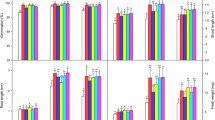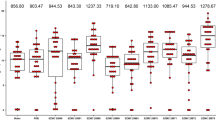Abstract—
The strain of facultative chemolithotrophic bacteria isolated from soil within the aphotic zone of the Kinderlinskaya Cave (Southern Urals, Russia) was identified as member of the species Advenella kashmirensis based on its phenotypic characteristics and sequencing of its 16S rRNA gene fragment. The novel isolate was similar to the type strain A. kashmirensis WT 001 in its ability to utilize thiosulfate as an energy source and to grow in the presence of 7% NaCl. The strain A. kashmirensis IB-K1 actively solubilized poorly soluble organic and mineral phosphorous compounds in in vitro experiments (solubilization indexes for phytin and calcium orthophosphate were 7 and 5, respectively). Moreover, these bacterial cells exhibited high activity of alkaline and acid phosphatases. Scanning electron microscopy of 4-day-old wheat seedling roots revealed active colonization of their rhizoplane by A. kashmirensis IB-K1 in the root hairs zone. The main mechanism of plant growth-promoting effect caused by the strain IB-K1 is probably associated with its phosphate-mobilizing activity and indoleacetic acid (IAA) production (up to 220 ± 42 ng/mL). Presowing treatment of wheat (Triticum durum Desf.) seeds with A. kashmirensis strain IB-K1 significantly alleviated the adverse effect of salinity stress on plant growth under moderate salinization level of cultured soil (at content of water-soluble salts 0.33 ± 0.06%), resulting in improvement of some parameters of yield structure and increased plant productivity. These findings are the first demonstration of the possible application of Advenella species in agricultural crop protection and plant growth stimulation under salinity stress.




Similar content being viewed by others
REFERENCES
Agrokhimicheskie metody issledovanii pochv (Agrochemical Methods in Soil Studies), Sokolov, A.V., Ed., Moscow: Nauka, 1975.
Alavi, P., Starcher, M., Zachow, C., Müller, H., and Berg, G., Root-microbe systems: the effect and mode of interaction of stress protecting agent (SPA) Stenotrophomonas rhizophila DSM14405T, Front. Plant Sci., 2013, vol. 4, art. 141, pp. 1–10. https://doi.org/10.3389/fpls.2013.00141
Arkhipova, T.N., Kuzmina, L.Yu., and Kudoyarova, G.R., Hormone-producing and growth-stimulating microorganisms decrease the level of oxidative stress in wheat plants under high-salinity conditions, Biomika, 2018, vol. 10, pp. 365‒371. https://doi.org/10.31301/2221-6197.bmcs.2018-47
Bunsangiam, S., Sakpuntoon, V., Srisuk, N., Ohashi, T., Fujiyama, K., and Limtong, S., Biosynthetic pathway of indole-3-acetic acid in Basidiomycetous yeast Rhodosporidiobolus fluvialis, Mycobiology, 2019, vol. 47, pp. 292–300. https://doi.org/10.1080/12298093.2019.1638672
Chervyatsova, O.Ya., Potapov, S.S., and Sadykov, S.A., Sulfur isotope composition of sulfate sediments karst caves of the Urals, Izv. Ural State Mining Univ., 2016, vol. 42, no. 2, pp. 32–36. https://doi.org/10.21440/2307-2091-2016-2-32-41
Chu, T.N., Tran, H.B.T., Bui, L.V., and Hoang, M.T.T., Plant growth-promoting rhizobacterium Pseudomonas PS01 induces salt tolerance in Arabidopsis thaliana, BMC Res. Notes, 2019, vol. 12, art. 11, pp. 1–7. https://doi.org/10.1186/s13104-019-4046-1
Coenye, T., Vanlaere, E., Samyn, E., Falsen, E., Larsson, P., and Vandamme, P., Advenella incenata gen. nov., sp. nov., a novel member of the Alcaligenaceae, isolated from various clinical samples, Int. J. Syst. Evol. Microb-iol., 2005, vol. 55, pp. 251–256. https://doi.org/10.1099/ijs.0.63267-0
Dobrovol’skaya, T.G., Khusnetdinova, K.A., Manucharova, N.A., and Golovchenko, A.V., Structure of epiphytic bacterial communities of weeds, Microbiology (Moscow), 2017, vol. 86, pp. 257‒263. https://doi.org/10.1134/S0026261717020072
Doronina, N.V., Torgonskaya, M.L., Fedorov, D.N., and Trotsenko, Yu.A., Aerobic methylobacteria as promising objects of modern biotechnology, Appl. Biochem. Microbio-l., 2015, vol. 51, pp. 125–134. https://doi.org/10.1134/S0003683815020052
Dospekhov, B.A., Metodika polevogo opyta (Methodology of Field Experiment), Moscow: Agropromizdat, 1985.
Egamberdieva, D., Davranov, K., Wirth, S., Hashem, A., and Abd_Allah, E.F., Impact of soil salinity on the plant-growth – promoting and biological control abilities of root associated bacteria, Saudi J. Biol. Sci., 2017, vol. 24, pp. 1601‒1608. https://doi.org/10.1016/j.sjbs.2017.07.004
Emtsev, V.T., Sokolova, A.Y., and Selitskaya, O.V., Protective effect of Klebsiella bacteria on lawn grasses under conditions of soil salinization, Euras. Soil Sci., 2010, vol. 43, pp. 771‒776.
Galbally, I.E. and Kirstine, W., The production of methanol by flowering plants and the global cycle of methanol, J. Atmosph. Chem., 2002, vol. 43, pp. 195–229. https://doi.org/10.1023/A:1020684815474
Galimzyanova, N.F., Kuzmina, L.Yu., Kudoyarova, G.R., Vysotskaya, L.B., Arkhipova, T.N., Sidorova, L.V., Guvatova, Z.G., Ryabova, A.S., Ionina, V.I., Gabbasova, I.M., and Melent’ev, A.I., Effect of pre-sowing seed bacterization with phosphate-mobilizing and auxin-producing microorganisms on wheat productivity and mobility of soil phosphorus in the rhizosphere, Agrokhimiya, 2018, no. 4, pp. 50–58. https://doi.org/10.7868/S0002188118040075
Gerhardt, P. and Am. Soc. Microbiol., Manual of Methods for General Bacteriology, Washington: Am. Soc. Microbiol., 1981.
Ghosh, W., Bagchi, A., Mandal, S., Dam, B., and Roy, P., Tetrathiobacter kashmirensis gen. nov., sp. nov., a novel mesophilic, neutrophilic, tetrathionate-oxidizing, facultatively chemolithotrophic betaproteobacterium isolated from soil from a temperate orchard in Jammu and Kashmir, India, Int. J. Syst. Evol. Microbiol., 2005, vol. 55, pp. 1779–1787. https://doi.org/10.1099/ijs.0.63595-0
Ghosh, W., George, A., Agarwal, A., Raj, P., Alam, M., Pyne, P., and Das Gupta, S.K., Whole-genome shotgun sequencing of the sulfur-oxidizing chemoautotroph Tetrathiobacter kashmirensis, J. Bacteriol., 2011, vol. 193, pp. 5553–5554. https://doi.org/10.1128/JB.05781-11
Gibello, A., Velo, A.I., Martin, M., Barra-Caracciolo, A., Grenni, P., and Fernandez-Garayzabal, J.F., Reclassification of the members of the genus Tetratiobacter Ghosh et al. 2005 to the genus Advenella Coenye et al. 2005, Int. J. Syst. Evol. Microbiol., 2009, vol. 59, pp. 1914–1918. https://doi.org/10.1099/ijs.0.007443-0
Glickman, E. and Dessaux, Y., A critical examination of the specificity of the Salkowski reagent for indolic compounds produced by phytopathogenic bacteria, Appl. Environ. Microbiol., 1995, vol. 61, pp. 793‒796. https://doi.org/10.1128/aem.61.2.793-796.1995
Goldstein, A.H. and Krishnaraj, P.U., Phosphate solubilizing microorganisms vs. phosphate mobilizing microorganisms: What separates a phenotype from a trait?, Developments in Plant and Soil Sciences, First International Meeting on Microbial Phosphate Solubilization, Velazquez, E. and Rodriguez-Barrueco, C., Eds., Dordrecht: Springer, 2007, vol. 102, pp. 203–213. https://doi.org/10.1007/978-1-4020-5765-6_31
Hu, H., Tang, C., and Rengel, Z., Influence of phenolic acids on phosphorus mobilization in acidic and calcareous soils, Plant Soil, 2005, vol. 268, pp. 173–180. https://doi.org/10.1007/s11104-004-0280-x
Jin, F., Ding, Y., Reddi, M.S., Dilantha Fernando, W.G., and Du, B., Genetic diversity and phylogeny of antagonistic bacteria against Phytophthora nicotianae isolated from tobacco rhizosphere, Int. J. Mol. Sci., 2011, vol. 12, pp. 3055–3071. https://doi.org/10.3390/ijms12053055
Khan, A.A., Jilani, G., Akhtar, M.S., Naqvi, S.M.S., and Rasheed, M., Phosphorus solubilizing bacteria: occurrence, mechanisms and their role in crop production, J. Agric. Biol. Sci., 2009, vol. 1, pp. 48–58.
Kiryushin, V.I., Ekologicheskie osnovy zemledeliya (Ecological Principles of Agriculture), Moscow: Kolos, 1996.
Lur’e, Yu.Yu., Unifitsirovannye metody analiza vod (Unified Methods of Water Analysis), Moscow: Khimiya, 1973.
Matsuoka, M., Park, S., An, S.Y., Miyahara, M., Rim, S.M., Kamino, K., Fushinobu, S., Yokota, A., Wakagi, T., and Shoun, H., Advenella faeciporci sp. nov., a nitrite-denitritfying bacterium isolated from nitrifying-denitritfying activated sludge collected from a laboratory-scale bioreactor treating piggery wastewater, Int. J. Syst. Evol. Micro-biol., 2012, vol. 62, pp. 2986–2990. https://doi.org/10.1099/ijs.0.037440-0
Moawad, M.E.P. and Vleck, P.L.G., Effect of phosphate solubilizing Pseudomonas putida on the growth of maize and its survival in the rhizosphere, Indones. J. Crop Sci., 1996, vol. 11, pp. 13–23.
Nassal, D., Spohn, M., Eltlbany, N., Jacquiod, S., Smalla, K., Marhan, S., and Kandeler, E., Effects of phosphorus-mobilizing bacteria on tomato growth and soil microbial activity, Plant Soil, 2018, vol. 427, pp. 17–37. https://doi.org/10.1007/s11104-017-3528-y
Numan, M., Bashir, S., Khan, Y., Mumtaza, R., Shinwar, Z.K., Khan, A.L., Khan, A., and Al-Harrasi, A., Plant growth promoting bacteria as an alternative strategy for salt tolerance in plants: a review, Microbiol. Res., 2018, vol. 209, pp. 21–32. https://doi.org/10.1016/j.micres.2018.02.003
Pan, J., Peng, F., Xue, X., You, Q., Zhang, W., Wang, T., and Huang, C., The growth promotion of two salt-tolerant plant groups with PGPR inoculation: a meta-analysis, Sustainability, 2019, vol. 11, art. 378, pp. 1–14. https://doi.org/10.3390/su11020378
Poroshina, M.N., Doronina, N.V., Kaparullina, E.N., and Trotsenko, Iu.A., Advenella kashmirensis subsp. methylica PK1, a facultative methylotroph from carex rhizosphere, Microbiology (Moscow), 2015, vol. 84, pp. 73–79. https://doi.org/10.1134/S0026261715010117
Prinsen, E., Costacurta, A., Michiels, K., Vanderleyden, J., and Van Onckelen, H., Azospirillum brasilense indole-3-acetic acid biosynthesis: evidence for a non-tryptophan dependent pathway, Mol. Plant Microbe Interact., 1993, vol. 6, pp. 609–615. https://doi.org/10.1094/MPMI-6-609
Pyne, P., Alam, M., and Ghosh, W., A novel soxO gene, encoding a glutathione disulfide reductase, is essential for tetrathionate oxidation in Advenella kashmirensis, Microbio-l. Res., 2017, vol. 205, pp. 1–7. https://doi.org/10.1016/j.micres.2017.08.002
Shahi, S.K., Rai, A.K., Tyagi, M.B., Sinha, R.P., and Kumar, A., Rhizosphere of rice plants harbor bacteria with multiple plant growth promoting features, Afr. J. Biotechn-ol., 2011, vol. 10, pp. 8296–8305. https://doi.org/10.5897/AJB11.602
Singh, P., Kumar, V., and Agrawal, S., Evaluation of phytase producing bacteria for their plant growth promoting activities, Int. J. Microbiol., 2014, art. 426483, pp. 1–7. https://doi.org/10.1155/2014/426483
Sugiyama, J., Kiyuna, T., Nishijima, M., An, K.-D., Nagatsuka, Y., Tazato, N., Handa, Y., Hata-Tomita, J., Sato, Y., Kigawa, R., and Sano, C., Polyphasic insights into the microbiomes of the Takamatsuzuka Tumulus and Kitora Tumulus, J. Gen. Appl. Microbiol., 2017, vol. 63, pp. 63–113. https://doi.org/10.2323/jgam.2017.01.007
Sura-de Jong, M., Reynolds, R.J.B., Richterova, K., Musilova, L., Staicu, L.C., Chocholata, I., Cappa, J.J., Taghavi, S., van der Lelie, D., Frantik, T., Dolinova, I., Strejcek, M., Cochran, A.T., Lovecka, P., and Pilon-Smits, E.A.H., Selenium hyperaccumulators harbor a diverse endophytic bacterial community characterized by high selenium resistance and plant growth promoting properties, Front. Plant Sci., 2015, vol. 6, art. 113, pp. 1‒17. https://doi.org/10.3389/fpls.2015.00113
Szegi, J., Talajmikrobiológiai vizsgálati módszerek (Methods of Soil Microbiology), Budapest, 1979.
Veselov, S.Yu., Kudoyarova, G.R., Egutkin, N.L., Guili-Zade, V.Z., Mustafina, A.R., and Kof, E.M., Modified solvent partitioning scheme providing increased specificity and rapidity of immunoassay for indole 3-acetic acid, Physiol. Plant., 1992, vol. 86, pp. 93‒96. https://doi.org/10.1111/j.1399-3054.1992.tb01316.x
Wang, H., Zhou, S., Wang, Y., Kong, D., Guo, X., Zhu, J., Dong, W., and Ruan, Z., Advenella alkanexedens sp. nov., an alkane-degrading bacterium isolated from biogas slurry samples, Int. J. Syst. Evol. Microbiol., 2016, vol. 66, pp. 906‒911. https://doi.org/10.1099/ijsem.0.000811
Wübbeler, J.H., Lütke-Eversloh, T., Van Trappen, S., Vandamme, P., and Steinbüchel, A., Tetratiobacter mimigardefordensis sp. nov., isolated from compost, a betaproteobacterium capable of utilizing the organic disulfide 3,3-dithiodipropionic acid, Int. J. Syst. Evol. Microbiol., 2006, vol. 56, pp. 1305‒1310. https://doi.org/10.1099/ijs.0.64126-0
Zhang, P., Jin, T., Sahu, S.K., Xu, J., Shi, Q., Liu, H., and Wang, Y., The distribution of tryptophan-dependent indole-3-acetic acid synthesis pathways in bacteria unraveled by large-scale genomic analysis, Molecules, 2019, vol. 24, art. 1411, pp. 1–14. https://doi.org/10.3390/molecules24071411
ACKNOWLEDGMENTS
The authors are grateful to I.I. Musabirov (Institute for Metals Superplasticity Problems, Russian Academy of Sciences, Ufa) for his assistance in conducting SEM studies.
Funding
This work was supported by the state budget of the Ministry of Education and Science of the Russian Federation, project no. AAAA-A18-118022190098-9 “Ecological and Genetic-Physiological Features of the Interaction of Species in Natural and Artificial Communities of Microorganisms,” as well as by the Russian Foundation for Basic Research, project no. 18-04-00577/18 “The Ability of Halotolerant Bacteria to Produce Phytohormones and Influence the Salt Tolerance of Plants.” The study was conducted using the equipment of the Agidel Center for Collective Use of the Ufa Federal Research Center, Russian Academy of Sciences.
Author information
Authors and Affiliations
Corresponding author
Ethics declarations
Conflict of interests. The authors declare that they have no conflict of interest.
Statement of the welfare of animals. This article does not contain any studies involving animals or human participants performed by any of the authors.
Additional information
Translated by E. Babchenko
Rights and permissions
About this article
Cite this article
Kuzmina, L.Y., Gilvanova, E.A., Galimzyanova, N.F. et al. Characterization of the Novel Plant Growth-Stimulating Strain Advenella kashmirensis IB-K1 and Evaluation of Its Efficiency in Saline Soil. Microbiology 91, 173–183 (2022). https://doi.org/10.1134/S0026261722020072
Received:
Revised:
Accepted:
Published:
Issue Date:
DOI: https://doi.org/10.1134/S0026261722020072




